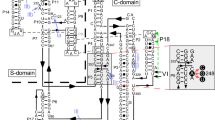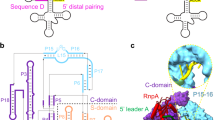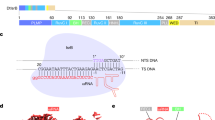Abstract
Transfer RNAs (tRNAs) are synthesized as part of longer primary transcripts that require processing of both their 3′ and 5′ extremities in every living organism known. The 5′ side is processed (matured) by the ubiquitously conserved endonucleolytic ribozyme, RNase P1, whereas removal of the 3′ tails can be either exonucleolytic2,3 or endonucleolytic4. The endonucleolytic pathway is catalysed by an enzyme known as RNase Z, or 3′ tRNase5,6. RNase Z cleaves precursor tRNAs immediately after the discriminator base (the unpaired nucleotide 3′ to the last base pair of the acceptor stem, used as an identity determinant by many aminoacyl-tRNA synthetases) in most cases6,7,8, yielding a tRNA primed for addition of the CCA motif by nucleotidyl transferase. Here we report the crystal structure of Bacillus subtilis RNase Z at 2.1 Å resolution, and propose a mechanism for tRNA recognition and cleavage. The structure explains the allosteric properties of the enzyme, and also sheds light on the mechanisms of inhibition by the CCA motif and long 5′ extensions. Finally, it highlights the extraordinary adaptability of the metallo-hydrolase domain of the β-lactamase family for the hydrolysis of covalent bonds.
This is a preview of subscription content, access via your institution
Access options
Subscribe to this journal
Receive 51 print issues and online access
$199.00 per year
only $3.90 per issue
Buy this article
- Purchase on Springer Link
- Instant access to full article PDF
Prices may be subject to local taxes which are calculated during checkout




Similar content being viewed by others
References
Frank, D. N. & Pace, N. R. Ribonuclease P: unity and diversity in a tRNA processing ribozyme. Annu. Rev. Biochem. 67, 153–180 (1998)
Garber, R. L. & Altman, S. In vitro processing of B. mori transfer RNA precursor molecules. Cell 17, 389–397 (1979)
Li, Z. & Deutscher, M. P. Maturation pathways for E. coli tRNA precursors: a random multienzyme process in vivo. Cell 86, 503–512 (1996)
Garber, R. L. & Gage, L. P. Transcription of a cloned Bombyx mori tRNA2Ala gene: nucleotide sequence of the tRNA precursor and its processing in vitro. Cell 18, 817–828 (1979)
Schiffer, S., Rosch, S. & Marchfelder, A. Assigning a function to a conserved group of proteins: the tRNA 3′-processing enzymes. EMBO J. 21, 2769–2777 (2002)
Nashimoto, M. Distribution of both lengths and 5′ terminal nucleotides of mammalian pre-tRNA 3′ trailers reflects properties of 3′ processing endoribonuclease. Nucleic Acids Res. 25, 1148–1154 (1997)
Kunzmann, A., Brennicke, A. & Marchfelder, A. 5′ end maturation and RNA editing have to precede tRNA 3′ processing in plant mitochondria. Proc. Natl Acad. Sci. USA 95, 108–113 (1998)
Schierling, K., Rosch, S., Rupprecht, R., Schiffer, S. & Marchfelder, A. tRNA 3′ end maturation in archaea has eukaryotic features: the RNase Z from Haloferax volcanii. J. Mol. Biol. 316, 895–902 (2002)
Pellegrini, O., Nezzar, J., Marchfelder, A., Putzer, H. & Condon, C. Endonucleolytic processing of CCA-less tRNA precursors by RNase Z in Bacillus subtilis. EMBO J. 22, 4534–4543 (2003)
Tavtigian, S. V. et al. A candidate prostate cancer susceptibility gene at chromosome 17p. Nature Genet. 27, 172–180 (2001)
Minagawa, A., Takaku, H., Takagi, M. & Nashimoto, M. A novel endonucleolytic mechanism to generate the CCA 3′ termini of tRNA molecules in Thermotoga maritima. J. Biol. Chem. 279, 15688–15697 (2004)
Mohan, A., Whyte, S., Wang, X., Nashimoto, M. & Levinger, L. The 3′ end CCA of mature tRNA is an antideterminant for eukaryotic 3′-tRNase. RNA 5, 245–256 (1999)
Brunger, A. T. et al. Crystallography & NMR system: A new software suite for macromolecular structure determination. Acta Crystallogr. D 54, 905–921 (1998)
Schiffer, S., Helm, M., Theobald-Dietrich, A., Giege, R. & Marchfelder, A. The plant tRNA 3′ processing enzyme has a broad substrate spectrum. Biochemistry 40, 8264–8272 (2001)
Cameron, A. D., Ridderstrom, M., Olin, B. & Mannervik, B. Crystal structure of human glyoxalase II and its complex with a glutathione thiolester substrate analogue. Struct. Fold. Des. 7, 1067–1078 (1999)
Nashimoto, M., Wesemann, D. R., Geary, S., Tamura, M. & Kaspar, R. L. Long 5′ leaders inhibit removal of a 3′ trailer from a precursor tRNA by mammalian tRNA 3′ processing endoribonuclease. Nucleic Acids Res. 27, 2770–2776 (1999)
Vogel, A., Schilling, O., Niecke, M., Bettmer, J. & Meyer-Klaucke, W. ElaC encodes a novel binuclear zinc phosphodiesterase. J. Biol. Chem. 277, 29078–29085 (2002)
Daiyasu, H., Osaka, K., Ishino, Y. & Toh, H. Expansion of the zinc metallo-hydrolase family of the β-lactamase fold. FEBS Lett. 503, 1–6 (2001)
Carfi, A. et al. The 3-D structure of a zinc metallo-beta-lactamase from Bacillus cereus reveals a new type of protein fold. EMBO J. 14, 4914–4921 (1995)
Frazao, C. et al. Structure of a dioxygen reduction enzyme from Desulfovibrio gigas. Nature Struct. Biol. 7, 1041–1045 (2000)
Matthews, B. W. Solvent content of protein crystals. J. Mol. Biol. 33, 491–497 (1968)
CCP4. The CCP4 Suite: Programs for protein crystallography. Acta Crystallogr. D 50, 760–763 (1994)
Otwinowski, Z. & Minor, W. in Methods in Enzymology Vol. 276, Macromolecular Crystallography Part A (eds Carter, C. W. Jr & Sweet, R. M.) 307–326 (Academic, New York, 1997)
Uson, I. & Sheldrick, G. M. Advances in direct methods for protein crystallography. Curr. Opin. Struct. Biol. 9, 643–648 (1999)
Schneider, T. R. & Sheldrick, G. M. Substructure solution with SHELXD. Acta Crystallogr. D 58, 1772–1779 (2002)
Lu, G. FINDNCS: A program to detect non-crystallographic symmetries in protein crystals from heavy atom sites. J. Appl. Crystallogr. 32, 365–368 (1999)
Perrakis, A., Morris, R. & Lamzin, V. S. Automated protein model building combined with iterative structure refinement. Nature Struct. Biol. 6, 458–463 (1999)
Kleywegt, G. J. & Jones, T. A. in From First Map to Final Model (eds Bailey, S. R. H. & Waller, D.) 59–66 (SERC Daresbury Laboratory, Daresbury, UK, 1994)
Berman, H. M. et al. The Protein Data Bank. Nucleic Acids Res. 28, 235–242 (2000)
Acknowledgements
We thank M. Springer, D. Picot, R. Giégé, F. Allemand, V. Arluison and F. Dardel for discussions, S. Fieulaine and M. Pirocchi for help with the beam-line BM30A at the European Synchrotron Radiation Facility, and J.L. Popot for use of crystallography facilities and X-ray generator at the IBPC. This work was supported by the CNRS (UPR 9073), Université Paris VII-Denis Diderot, PRFMMIP 2001/2003, and ACI Jeunes Chercheurs from the Ministère de l'Education Nationale.
Author information
Authors and Affiliations
Corresponding author
Ethics declarations
Competing interests
The authors declare that they have no competing financial interests.
Supplementary information
Supplementary Figure S1
Shows an alignment COGs representing different members of the metallo -lactamase family. (PPT 1058 kb)
Supplementary Figure S2
Shows both the secondary structure features of RNase Z superimposed on its amino acid sequence and the secondary structure topology of the protein. (PPT 52 kb)
Supplementary Figure S3
Shows the crystal packing of RNase Z. (PPT 122 kb)
Supplementary Methods
Describes the seleno-methionine labelling of RNase Z. (RTF 3 kb)
Supplementary Table
Shows data-collection, phasing and refinement statistics for resolution of RNase Z structure. (RTF 304 kb)
Rights and permissions
About this article
Cite this article
de la Sierra-Gallay, I., Pellegrini, O. & Condon, C. Structural basis for substrate binding, cleavage and allostery in the tRNA maturase RNase Z. Nature 433, 657–661 (2005). https://doi.org/10.1038/nature03284
Received:
Accepted:
Published:
Issue Date:
DOI: https://doi.org/10.1038/nature03284
This article is cited by
-
A promiscuous ancestral enzyme´s structure unveils protein variable regions of the highly diverse metallo-β-lactamase family
Communications Biology (2021)
-
The transcription factor OsbHLH138 regulates thermosensitive genic male sterility in rice via activation of TMS5
Theoretical and Applied Genetics (2019)
-
Conformational dynamics of metallo-β-lactamase CcrA during catalysis investigated by using DEER spectroscopy
JBIC Journal of Biological Inorganic Chemistry (2015)
-
RNase ZS1 processes UbL40 mRNAs and controls thermosensitive genic male sterility in rice
Nature Communications (2014)
-
Evolution of the Genetic Code by Incorporation of Amino Acids that Improved or Changed Protein Function
Journal of Molecular Evolution (2013)
Comments
By submitting a comment you agree to abide by our Terms and Community Guidelines. If you find something abusive or that does not comply with our terms or guidelines please flag it as inappropriate.



